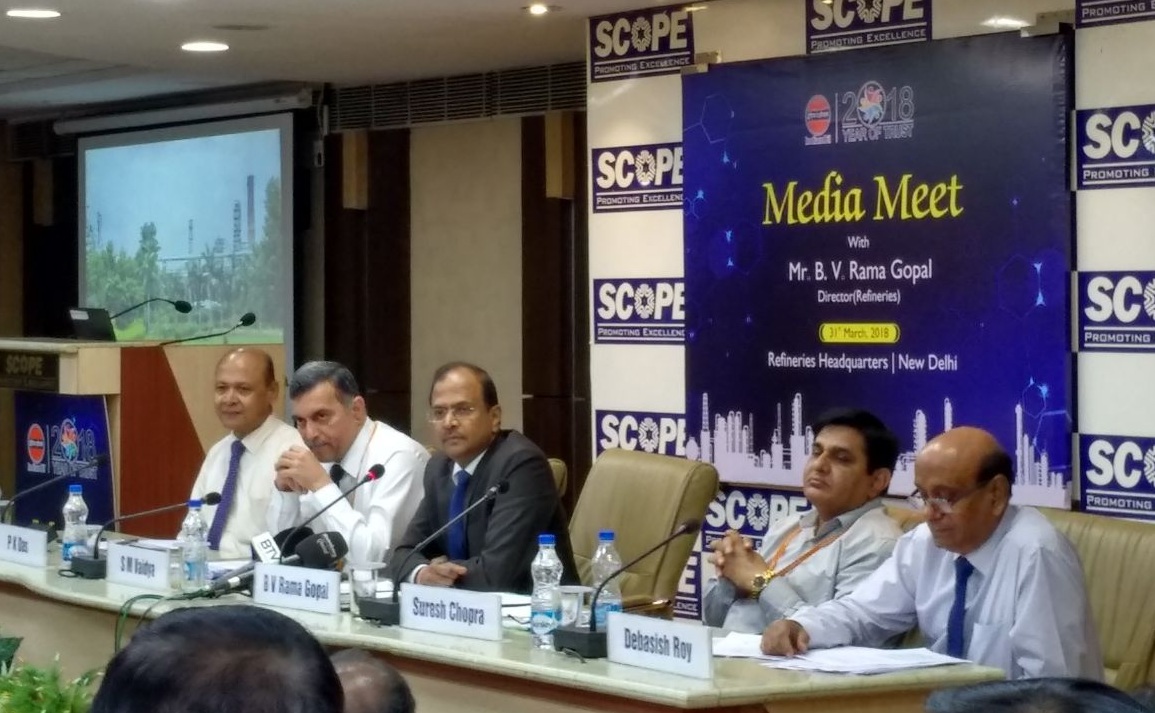Financial
IOC to Doubled Refining Capacity of 80.7 MMTPA

New Delhi: Indian Oil Corporation (Refineries Division) has embarked on an ambitious plan to increase the present installed refining capacity of 80.7 MMTPA, including the refining capacity of CPCL, to an estimated 150 (Including IOC, CPCL, and RRPCL) MMTPA by 2030 to take advantage of current favourable market scenario and the bright future projections.
IndianOil is committed to meet the advanced timelines for the supply of BS-VI grade auto fuels in NCT region from April 1, 2018. Briefing the Media persons Shri B V Rama Gopal, Director, Refineries, IndianOil, said, this shall be the outcome of planned brownfield expansions and greenfield projects. As on date, mega projects worth around Rs. 32,000 crore are in various stages of execution, and plans have been drawn up for implementation of projects worth approx Rs 1. 43 lakh crore in the next five years to be future-ready.
Highlights of IndianOil’s Refineries Division
IndianOil is committed to meet the advanced timelines for the supply of BS-VI grade auto fuels in NCT region from 1st April 2018 from its Mathura and Panipat Refineries. The fuel shall be made available from 187 retail outlets of IndianOil within Delhi. For the next milestone on April 1, 2019 (NCR & Metro cities), 101 IndianOil retail outlets shall be covered.
It is a challenge to reconfigure a running refinery for BS-VI compliance with units being revamped or new units being constructed in an operational refinery, but IndianOil Refineries Division has achieved this feat successfully. Construction activities are in full swing and fuel quality upgradation projects for production of BS-VI grade MS and HSD have achieved 42.5% physical progress till date.
For NCR Region:
1st April 2018: - NCT Delhi (as per Govt Notification)
1st jan 2019 - NCT Delhi + Bharatpur [Districts identified for Supplies are Alwar, Bharatpur, Karauli & Dhaulpur].
The date has been selected as 01.01.2019 instead of 01.10.18, as BORL will go under planned shutdown during Jul/Aug/Sep’18. Hence BS-VI Grade fuel is expected to be available from Oct’18 onwards, where three months will be required for facility upgradation/conversion from BS-IV Grade to BS -VI Grade.
NCT Delhi + Bharatpur + Meerut [ Districts identified for Supplies are Meerut, Muzzafarnagar, Ghaziabad, Gautam Budh Nagar, Baghpat, Hapur, Bulandshar & Shamli ].
BS-VI Fuel Supply to 13 metro cities including NCR
The Honourable Supreme Court has instructed MoP&NG for advancing supply of BS-VI fuels to 01.04.19 in 13 metro cities excluding NCR. Details are being worked out.
Govt. of India’s Path to Green Fuels
The increasing consumption of oil is directly linked to atmospheric pollution, and the health impact of the deteriorating ambient air quality linked to combustion of fuels is of serious concern in urban areas worldwide.
The Government of India has taken several policy measures and significant interventions to reduce vehicular emissions and improve fuel efficiency. India has followed the regulatory pathway for fuel quality and vehicle emissions standards termed as Bharat Stage (BS).
The transition has been in phases, considering the time and money that is required at the refinery end and in terms of vehicle production. India’s fuel quality standards have been gradually tightened since the mid-1990s. The fuel upgradation programme took off with notification of vehicular emission norms for new vehicles in 1991.
- The emission norms were revised in 1996. Leaded gasoline was introduced in 1994 in the four metros, Delhi, Mumbai, Kolkata and Chennai.
- On Feb 1, 2000, unleaded gasoline was mandated nationwide. BS 2000 (Euro I equivalent, Bharat Stage I) vehicle emission norms were introduced for new vehicles from April 2000.
- Bharat Stage II (Euro II equivalent) emission norms for new cars were introduced in Delhi from the year 2000 and extended to the other three metro cities in the year 2001.
- The emission norms for CNG and LPG vehicles were notified in the year 2000 and 2001, respectively.BS-III was implemented in phases during 2005-2010.T
- The current BS-IV fuel with 50 ppm (parts per million) sulphur was introduced in the year 2010 and it was to cover the entire country by 1-4-2017.
- In 2016, the Govt. of India decided to meet international best practices by leapfrogging directly from BS-IV to BS-VI norms by skipping BS-V altogether by 1st April, 2020.As the technology for BS V is not very different, it was rightly decided to go straight to BS VI grade fuels from BS IV.
- As part of its focus on clean energy, the Ministry of Petroleum & Natural Gas is actively promoting city gas distribution networks and connecting major cities with “green highways,” which will have vehicles running on CNG and LNG with adequate re-fuelling stations.Lakhs of households are getting the benefits of piped natural gas (PNG) supplies.
- 27.5 lakh vehicles in the country are benefiting from the availability of CNG. So far, 80 cities/districts of 19 States/UTs have been covered for development of PNG/CNG network.
News Must Read
- SJVN CMD Geeta Kapur Inaugurates Construction Works at Sunni Dam Project in Himachal Pradesh
- PESB Selects R Veerabahu as Director (Finance) for Braithwaite & Co. Limited
- Grew Energy bags largest order of 200 MW Contract of SECI's Auction
- CPCL Reports 39% YoY Drop in Q4 Net Profit, Declares Rs 55 per Share Dividend
- SJVN Limited inaugurates India's first Multi-purpose Green Hydrogen Pilot Project
- KRDCL, RVNL JV emerges as the Lowest Bidder for Redevelopment of Thiruvananthapuram Central Railway Station
- REC Ltd. has incorporated subsidiary company BPTL
- Hon’ble Vice President of India Confers `Outstanding PSU of the Year’ Award on HAL
- BharatPe Launches India’s first All-in-One Payment Device
- NBCC registers historical Performance in FY2023-24